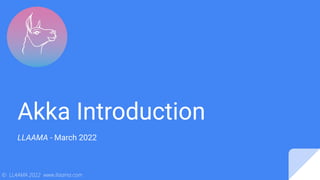The document provides an introduction to Akka, a Scala-based framework for building concurrent and distributed applications using the actor model. It covers various aspects of Akka, including actor hierarchies, message delivery, fault tolerance, and the benefits of using Akka clusters for developing reactive systems. Key ideas include the importance of immutability in message passing and the use of a gossip protocol for cluster management.























![● Actor references are available when actors are created
○ val greeter: ActorRef[HelloWorld.Greet] = context.spawn(HelloWorld(), “greeter”)
○ ActorRef<HelloWorld.Greet> greeter = context.spawn(HelloWorld.create(), “greeter”
● Actor references can be part of the message protocols
● Actor references correspond to real existing actors and are bound to their life-cycle
● Actor references can be obtained through the Receptionist
● Actor Paths are unique accessors, in form of path structures, from the actor
system, through the actor hierarchy to the actor itself
○ akka://actorsystem/user/a/b/c (local)
○ akka://actorsystem@host.example.com:5555/user/a/b/c (remote)
Akka Actor References and Addresses
© LLAAMA 2022](https://image.slidesharecdn.com/akka-intro-training-public-220323102128/85/Akka-intro-training-public-pdf-24-320.jpg)






























![Special Roles in Akka cluster
● Leader
○ Defined when (gossip) convergence is reached
○ No special node, just a role
○ Deterministic way to recognize it
○ Confirms states changes (e.g. joining -> up)
● Seed Nodes
○ Fixed entry points for nodes to join the cluster
○ No special other role
○ Can be defined in conf or as system.properties
○ First seed node needs to be available when starting the cluster
○ Cluster Bootstrap module enable automatic discovery of nodes
application.conf:
akka.cluster.seed-nodes = [
"akka://MyCluster@host1:2552",
"akka://MyCluster@host2:2552"]
JVM system properties:
-Dakka.cluster.seed-nodes.0=akka://ClusterSystem@host1:2552
-Dakka.cluster.seed-nodes.1=akka://ClusterSystem@host2:2552
© LLAAMA 2022](https://image.slidesharecdn.com/akka-intro-training-public-220323102128/85/Akka-intro-training-public-pdf-55-320.jpg)





























